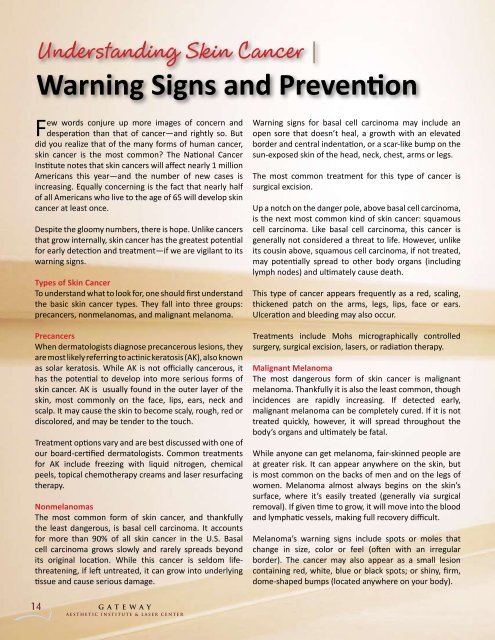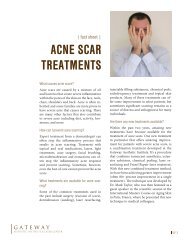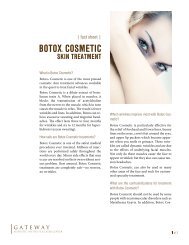The Largest Dedicated Cosmetic Laser Center In The - Gateway ...
The Largest Dedicated Cosmetic Laser Center In The - Gateway ...
The Largest Dedicated Cosmetic Laser Center In The - Gateway ...
Create successful ePaper yourself
Turn your PDF publications into a flip-book with our unique Google optimized e-Paper software.
Understanding Skin Cancer |<br />
Warning Signs and Prevention<br />
Few words conjure up more images of concern and<br />
desperation than that of cancer—and rightly so. But<br />
did you realize that of the many forms of human cancer,<br />
skin cancer is the most common? <strong>The</strong> National Cancer<br />
<strong>In</strong>stitute notes that skin cancers will affect nearly 1 million<br />
Americans this year—and the number of new cases is<br />
increasing. Equally concerning is the fact that nearly half<br />
of all Americans who live to the age of 65 will develop skin<br />
cancer at least once.<br />
Despite the gloomy numbers, there is hope. Unlike cancers<br />
that grow internally, skin cancer has the greatest potential<br />
for early detection and treatment—if we are vigilant to its<br />
warning signs.<br />
Types of Skin Cancer<br />
To understand what to look for, one should first understand<br />
the basic skin cancer types. <strong>The</strong>y fall into three groups:<br />
precancers, nonmelanomas, and malignant melanoma.<br />
Precancers<br />
When dermatologists diagnose precancerous lesions, they<br />
are most likely referring to actinic keratosis (AK), also known<br />
as solar keratosis. While AK is not officially cancerous, it<br />
has the potential to develop into more serious forms of<br />
skin cancer. AK is usually found in the outer layer of the<br />
skin, most commonly on the face, lips, ears, neck and<br />
scalp. It may cause the skin to become scaly, rough, red or<br />
discolored, and may be tender to the touch.<br />
Treatment options vary and are best discussed with one of<br />
our board-certified dermatologists. Common treatments<br />
for AK include freezing with liquid nitrogen, chemical<br />
peels, topical chemotherapy creams and laser resurfacing<br />
therapy.<br />
Nonmelanomas<br />
<strong>The</strong> most common form of skin cancer, and thankfully<br />
the least dangerous, is basal cell carcinoma. It accounts<br />
for more than 90% of all skin cancer in the U.S. Basal<br />
cell carcinoma grows slowly and rarely spreads beyond<br />
its original location. While this cancer is seldom lifethreatening,<br />
if left untreated, it can grow into underlying<br />
tissue and cause serious damage.<br />
14 gateway<br />
aesthetic <strong>In</strong>stitute & <strong>Laser</strong> <strong>Center</strong><br />
Warning signs for basal cell carcinoma may include an<br />
open sore that doesn’t heal, a growth with an elevated<br />
border and central indentation, or a scar-like bump on the<br />
sun-exposed skin of the head, neck, chest, arms or legs.<br />
<strong>The</strong> most common treatment for this type of cancer is<br />
surgical excision.<br />
Up a notch on the danger pole, above basal cell carcinoma,<br />
is the next most common kind of skin cancer: squamous<br />
cell carcinoma. Like basal cell carcinoma, this cancer is<br />
generally not considered a threat to life. However, unlike<br />
its cousin above, squamous cell carcinoma, if not treated,<br />
may potentially spread to other body organs (including<br />
lymph nodes) and ultimately cause death.<br />
This type of cancer appears frequently as a red, scaling,<br />
thickened patch on the arms, legs, lips, face or ears.<br />
Ulceration and bleeding may also occur.<br />
Treatments include Mohs micrographically controlled<br />
surgery, surgical excision, lasers, or radiation therapy.<br />
Malignant Melanoma<br />
<strong>The</strong> most dangerous form of skin cancer is malignant<br />
melanoma. Thankfully it is also the least common, though<br />
incidences are rapidly increasing. If detected early,<br />
malignant melanoma can be completely cured. If it is not<br />
treated quickly, however, it will spread throughout the<br />
body’s organs and ultimately be fatal.<br />
While anyone can get melanoma, fair-skinned people are<br />
at greater risk. It can appear anywhere on the skin, but<br />
is most common on the backs of men and on the legs of<br />
women. Melanoma almost always begins on the skin’s<br />
surface, where it’s easily treated (generally via surgical<br />
removal). If given time to grow, it will move into the blood<br />
and lymphatic vessels, making full recovery difficult.<br />
Melanoma’s warning signs include spots or moles that<br />
change in size, color or feel (often with an irregular<br />
border). <strong>The</strong> cancer may also appear as a small lesion<br />
containing red, white, blue or black spots; or shiny, firm,<br />
dome-shaped bumps (located anywhere on your body).











